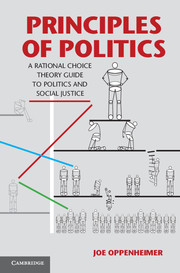Book contents
- Frontmatter
- Contents
- Propositions and Corollaries
- Tables
- Figures
- Sidebars
- Definitions
- Preface
- Overview of the Book
- Acknowledgments
- Introduction: Politics, Universals, Knowledge Claims, and Methods
- Part I The Logic of Collective Action
- Part II Collective Choice
- Part III Political Institutions and Quality Outcomes
- Chapter 6 Political Necessity and the Tethering of Leaders
- Chapter 7 A Few Institutional Pitfalls
- Part IV Social Justice, Choice, and Welfare
- Bibliography
- Name Index
- Subject Index
Chapter 7 - A Few Institutional Pitfalls
Published online by Cambridge University Press: 05 August 2012
- Frontmatter
- Contents
- Propositions and Corollaries
- Tables
- Figures
- Sidebars
- Definitions
- Preface
- Overview of the Book
- Acknowledgments
- Introduction: Politics, Universals, Knowledge Claims, and Methods
- Part I The Logic of Collective Action
- Part II Collective Choice
- Part III Political Institutions and Quality Outcomes
- Chapter 6 Political Necessity and the Tethering of Leaders
- Chapter 7 A Few Institutional Pitfalls
- Part IV Social Justice, Choice, and Welfare
- Bibliography
- Name Index
- Subject Index
Summary
As argued in Chapter 6, governments, with their political institutions and behaviors called politics, are necessary for society as we know it. But good public policy requires responsiveness to some collective interests, some understanding of the notion of social welfare: a concept that we will delve into in the next section. But even without that understanding, we can see that the proper design of political institutions and processes requires careful analysis of the multiple values one is trying to satisfy and some sense that one can make justifiable tradeoffs between these multiple values while staying responsive to the needs of the citizens.
To control and design a more responsive government we must consider how its structural characteristics create or block incentives of the political system to achieve these values. To do this, we turn again to the notion of a veto player (Tsebelis, 2002), a type of actor that is created by the design of political institutions. Veto players are part of all political systems and their nature will bring us to examine Sen’s (1970) Liberal Paradox and the observation that veto players must have the incentives and possibilities to get us beyond the status quo.
- Type
- Chapter
- Information
- Principles of PoliticsA Rational Choice Theory Guide to Politics and Social Justice, pp. 161 - 184Publisher: Cambridge University PressPrint publication year: 2012



